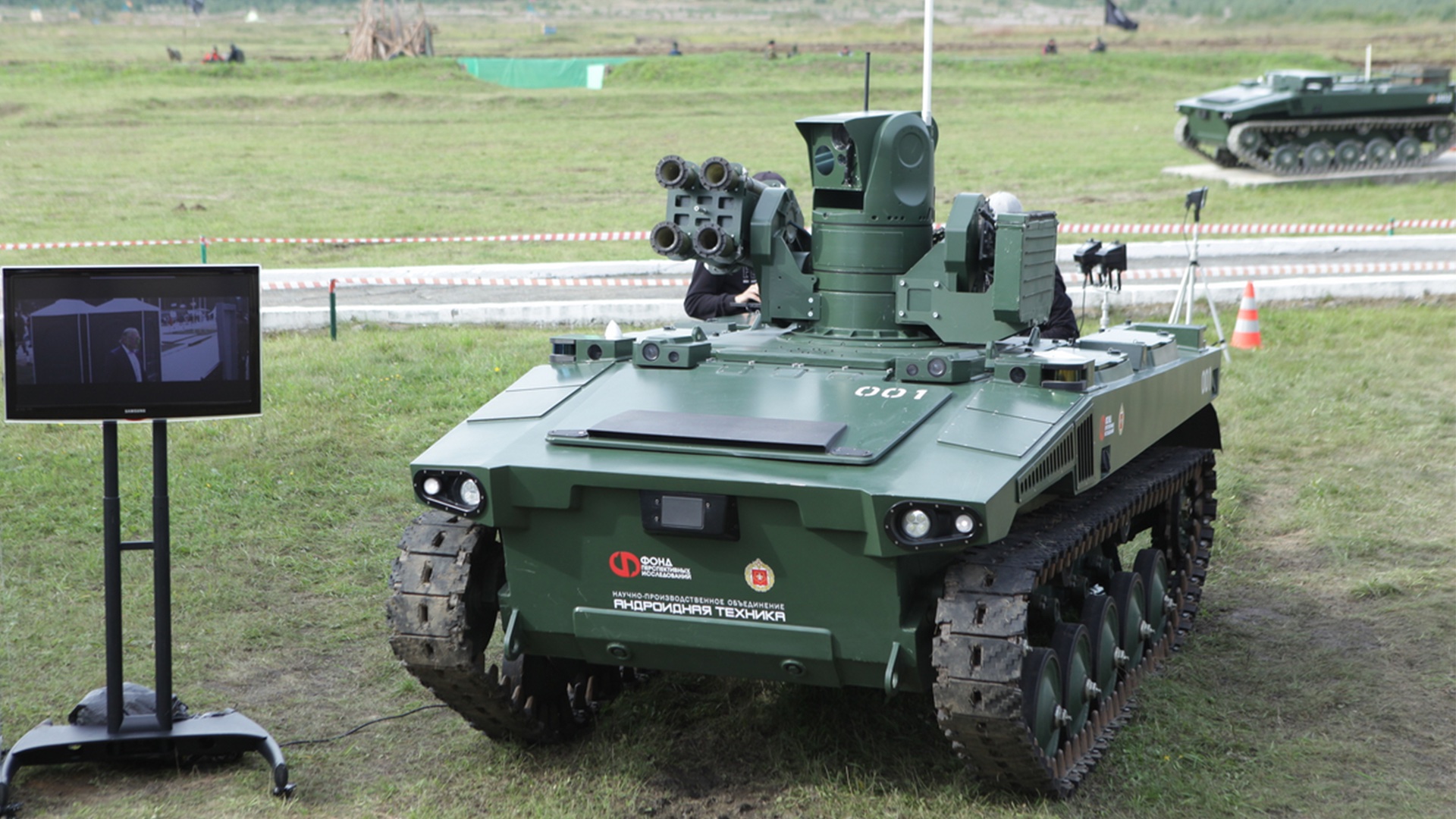

After months of asking, the Ukrainian military is set to receive more than 100 western-made main battle tanks from its international allies, including 31 U.S. M1 Abrams tanks, 14 British Challenger 2 tanks, and about 80 German-built Leopard 2 tanks.
But while the arrival of western armor in Ukraine may appear something to celebrate, Russia says it is already planning on deploying possible countermeasures including, apparently, an unmanned ground vehicle (UGV) modified to become a robotic tank killer.
Speaking to RIA Novosti last week, Dmitriy Rogozin — the former Russian space chief who currently serves as the head of a group of military advisors calling itself the “Royal Wolves” or “Tsar’s Wolves” — announced that those western-built tanks can expect to meet a modified version of the Russian military’s Marker UGV armed with anti-tank missile on the battlefields of eastern Ukraine
“Everyone agrees that our strike Marker should be prepared for their destruction along with the crews in the remaining time before the arrival of the Abrams and Leopards in Ukraine,” Rogozin said.
Subscribe to Task & Purpose Today. Get the latest military news, entertainment, and gear in your inbox daily.
The Marker is a UGV, either wheeled or tracked, developed by Android Technologies and the Advanced Research Foundation, essentially Russia’s equivalent of the United States’ Defense Advanced Research Projects Agency (DARPA).
Currently, there are just five Markers in existence, and according to Rogozin, four of them are being sent to the Donbas region of Ukraine.
“What’s interesting is that Marker was always presented as a proof of concept, a flagship project for ‘general AI artificial intelligence] applications,” said Samuel Bendett, a member of the Russia Studies Program and adjunct senior fellow at the Center for New American Security. “So deploying it raises more questions than answers.”
The Marker was previously tested, like many Russian-made UGVs, primarily in a reconnaissance and intelligence gathering role, where it could travel remotely and launch small unmanned aerial vehicles as reconnaissance platforms.
While these previous tests were conducted in complex spaces like forests, according to Bendett, those environments are nothing approaching the sheer chaos the vehicle might expect to face in an actual combat situation in Donbas.
“It may have gone through classified testing that we are not privy to,” said Bendett. “But Donbas is not a controlled environment. It’s saturated with weapons and countermeasures.”
Russia has a long history of using the battlefield to test new technology. Indeed, the Russian military previously fielded the Uran-9 UGV in Syria beginning in 2018, but the weapon-laden vehicle was fraught with so many problems — a range of just 300 to 500 meters, frequent breakdowns, and loss of control from the human operator — that even Russian defense officials acknowledged it was “not capable of performing the tasks assigned to it.” (Still, the Uran-9 was adopted by the Russian military and Russian state media reported last year that it had been deployed to Ukraine.)
“Some of what may be happening here is that there have been a lot of Russian projects similar to Marker in development for some time,” said Bendett. “Russia needs to field this new technology to show that it can do so.”
With only four Marker vehicles in its fleet, Bendett said the touting of these UGVs as potential tank killers is likely just a public relations stunt, and they are unlikely to see any use outside of an extremely controlled environment.
As to what the Marker can field, well in theory, a lot. As a test-bed vehicle, Bendett likened it to Legos — fitting on whatever can conceivably be mounted. That doesn’t necessarily mean it will work in the field.
Announcing that they can destroy a tank also raises questions about the use of UGVs on the battlefield.
“The whole point of fielding a UGV is to take humans out of a dangerous environment. But in all the discussions that have taken place throughout Russian military academia, no one ever talked about what happens when the vehicle is destroyed,” said Bendett. “And if soldiers have to recover the UGV, that negates the whole purpose.”
This may prove a challenge for Russia. In Syria, for example, the Uran-9’s terrible range didn’t do much for the whole keeping “humans out of a dangerous environment” element of robot warfare. And with only four systems in existence, the Marker isn’t exactly “expendable,” as Bendett said. Neither are those western-built tanks delivered to Ukraine, but when it comes to survivability on the battlefield, an Abrams tank stands a better chance than a UGV. Despite this, the war in Ukraine will undoubtedly serve as yet another testing ground for figuring out what, exactly, UGVs can do in combat.
“The real question is to what extent Russia and Ukraine will continue to experiment with these systems,” said Bendett.
The latest on Task & Purpose
- The Army’s futuristic new goggles actually make soldiers less lethal, Pentagon weapons tester says
- Marines outwitted an AI security camera by hiding in a cardboard box and pretending to be trees
- Watch a German Leopard 2 tank carry a beer and not spill a drop
- The Air Force is moving forward with a replacement for its decades-old long-range radar
- India rolls out mortar-toting camo camels for military parade
Want to write for Task & Purpose? Click here.
